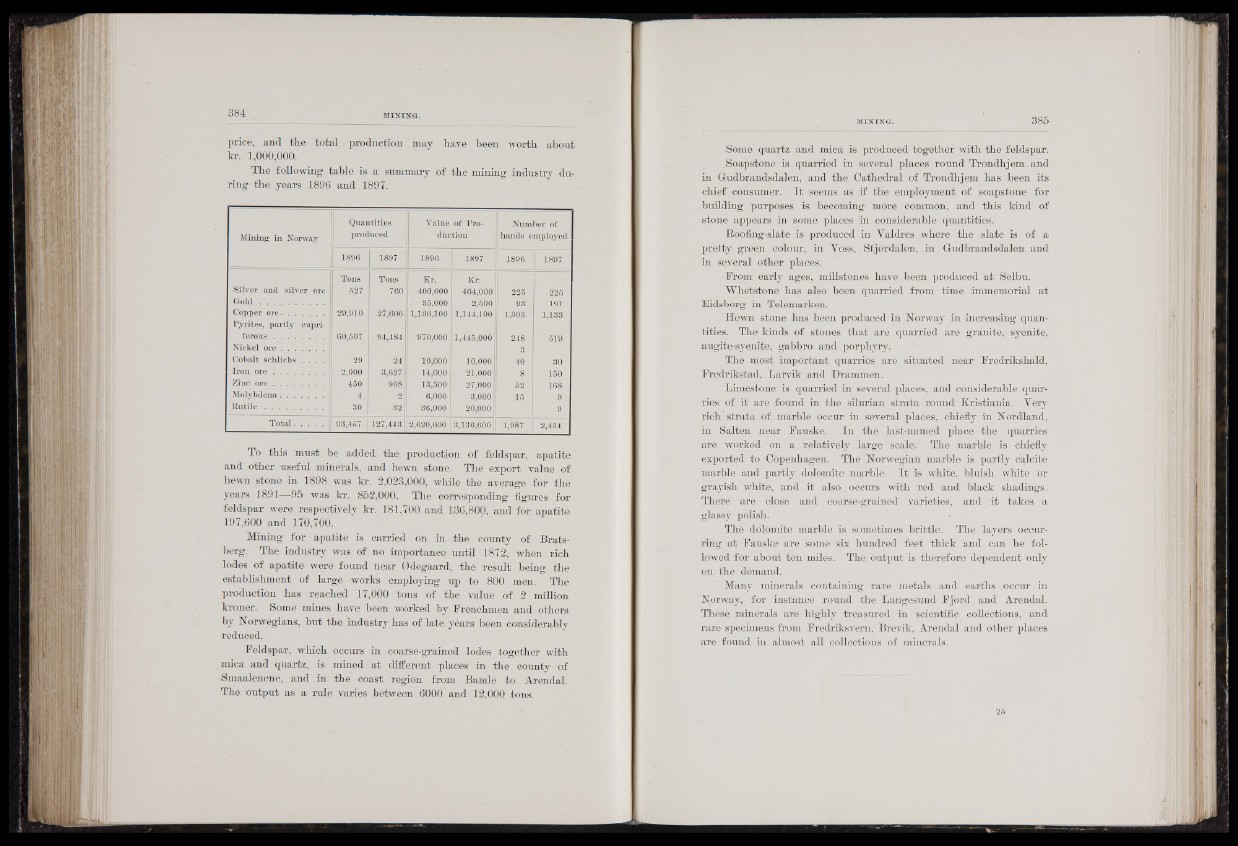
price, and the total ■ production may have been worth about
kr. 1,000,000.
The following table is a summary of the mining industry during
the years 1896 and 1897.
Mining in Norway
Quantities .
prodnced
Value of Production
Number of
hands employed
1896 -1897 1896 1897 1896 1897
Tons Tons Kr. Kr.
Silver and silver ore 627 760 400,000 464,000 225 1 225
Gold I ...................... 35,000 2,500 93 191
Copper o re ................... 29,910 27,606 1,136,100 1,144,100 1,3031 1,133
Pyrites, partly cuprif
e ro n s ...................... 60,507 94,484 970,000 1,445,000 248 519
Nickel ore . . . . . . . 3
Cobalt schliehs . . . . 29 24 10,000 10,000 40 30
Iron ore . . . . . wfSBM 2,00.0 3,627 14,000 • 21,000 8 150
450 908 13,500 27,000 52 168
Molybdena. . . . . . . 4 2 6j000 3,000 15 : 9
Rutile . . ................ 30 32 86,000 20,000 • 9
T o ta l............. 98,457 127,443 2,620,600 3,136,600 1,9871 2,434
To this must be added the production of feldspar, apatite
and other useful minerals, and hewn stone. The export value of
hewn stone in 1898 was kr. 2,023,000, while the average for the
years 1891^-95 was kr. 852,000. The corresponding figures for
feldspar were respectively kr. 181,700 and 136,800, and for apatite
197,600 and 170,700.
Mining for apatite is carried on in the county of Brats-
berg. The industry was of no importance until 1872, when rich
lodes of apatite were found near 0degaard, the result being the
establishment of large works employing up to 800 men. The
production has reached 17,000 tons of the value of 2 million
kroner. Some mines have been worked by Frenchmen and others
by Norwegians, but the industry has of late years been considerably
reduced.
Feldspar, which occurs in coarse-grained lodes together with
mica and quartz, is mined at different places in the county of
Smaalenene, and in the coast region from Bamle to Arendal.
The output as a rule varies between 6000 and 12,000 tons.
Some quartz and mica is produced together with the feldspar.
Soapstone is quarried in several places round Trondhjem and
in Gndbrandsdalen, and the Cathedral of Trondhjem has been its
chief consumer. I t seems as if the employment of soapstone for
building purposes is becoming more common, and this kind of
stone appears in some places in considerable quantities.
Boofing-slate is produced in Valdres where the slate is of a
pretty green colour, in Voss, Stjordalen, in Gudbrandsdalen and
in several other places.
From early ages, millstones have been produced at Selbu.
Whetstone has also been quarried from time immemorial at
Eidsborg in Telemarken.
Hewn stone has been produced in Norway in increasing quantities.
The kinds of stones that are quarried are granite, syenite,
augite-syenite, gabbro and porphyry.
The most important quarries are situated near Fredrikshald,
Fredrikstad, Larvik and Drammen.
Limestone is quarried in several places, and considerable quarries
of it are found in the silurian strata round Kristiania. Very,
rich strata of marble occur in several places, chiefly in Nordland,
in Salten n e a r, Fauske. In the last-named place the quarries
are worked on a relatively large scale. The marble is chiefly
jgxported to Copenhagen. The Norwegian marble is partly calcite
marble and partly dolomite marble. I t is white, bluish white or
grayish white, and it also occurs with red and black shadings.
There are close and coarse-grained varieties, and it takes a
glassy polish.
The dolomite marble is sometimes brittle. The layers occurring
at Fauske are some six hundred feet thick and can be followed
for about ten miles. The output is therefore dependent only
on the demand:
Many minerals containing rare metals and earths .occur in
Norway, for instance round the Langesund Fjord and Arendal.
These minerals are highly treasured in scientific collections, and
rare specimens from Fredriksvern, Brevik, Arendal and other places
are found in almost all collections of minerals.